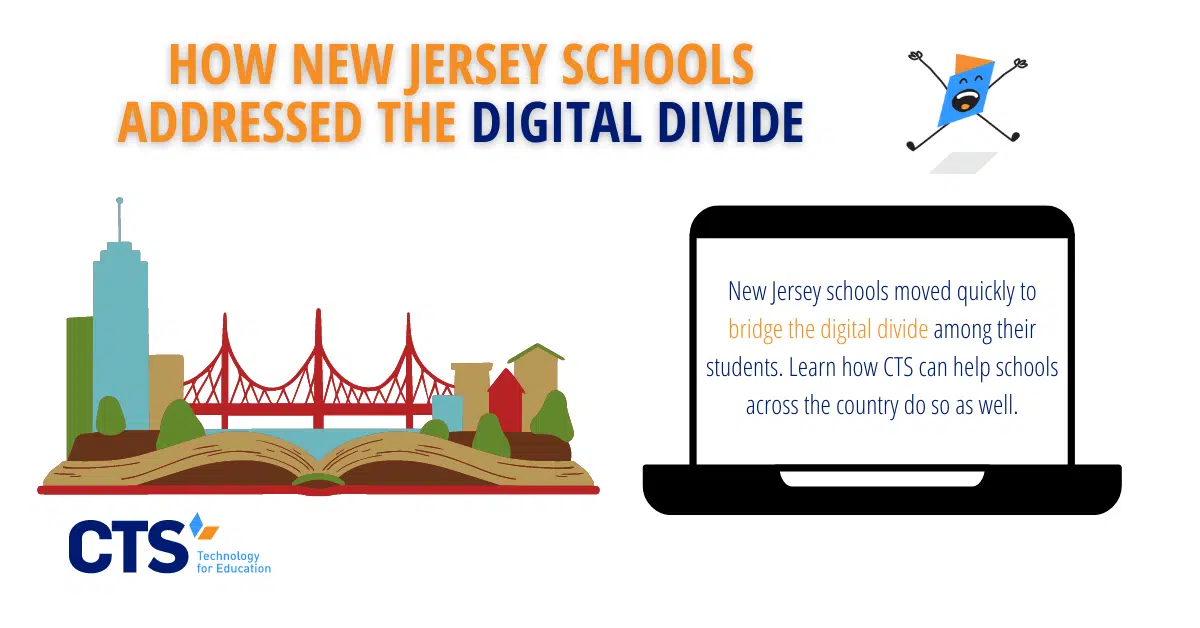New Jersey schools, like those across the country, faced issues of device equity at the beginning of the pandemic.
In March 2020, schools across the country raced to launch remote learning programs for thousands of students. While some schools already had enough devices on hand for each of their students, others weren’t so lucky and were forced to compete with other schools for a limited number of available devices. This mad dash was complicated by supply chain issues, making it even more difficult for schools to procure and distribute devices to students in need.
These problems were present in New Jersey schools, too. There, local and state leaders scrambled to identify which students lacked devices at home, sought to address gaps in student internet service, and kept lines of communication with students’ families open. The result? More than 300,000 students received some form of technology support, enabling them to make the most of remote learning programs. Below, we describe the steps state and local leaders took to address the digital divide among New Jersey residents and how CTS can support other schools in resolving issues of device equity among their students.
First, the schools moved to identify students who lacked devices at home.
Like other school districts across the country, New Jersey schools moved, first, to identify which of their students lacked either a school-issued device or consistent internet access at home. Without a laptop to access online instructional content or reliable internet service, less-resourced students had little hope of engaging with the school’s academic content.
Indeed, without access to their school’s wireless network, students who couldn’t get online at home were often forced either to go without or travel to a local library or coffee shop that hosted free internet access. In the pandemic’s early days, the latter wasn’t always a possibility, underscoring the challenges of rapidly scaling a remote learning program.
Even before the pandemic, students increasingly reported using the internet to complete school coursework at home. While many schools were slowly beginning to embrace one-to-one Chromebook ratios, widespread Google Classroom use, and online instructional platforms, the pandemic forced them to shift their efforts into high gear, often with uneven results.
Next, New Jersey schools sought to address gaps in students’ internet service.
Even after New Jersey schools did their best to identify and distribute devices to students in need, they still had to ensure students had reliable internet access at home. Even students who answered “yes” when asked if they were able to use the internet at home quickly discovered their service quality didn’t necessarily meet the demands of remote learning.
For some students, particularly those with siblings, their home wireless networks simply couldn’t handle the bandwidth required for multiple Zoom calls, document downloads and uploads, and the other day-to-day demands of remote learning. Parents who worked from home further compromised these students’ internet access, depriving them of daily instructional content.
To meet this need, school leaders distributed wireless internet hotspots to students whose home networks weren’t sufficient to handle the demands of remote learning. As many schools have returned to in-person instruction, school leaders have used the hotspots to continue meeting students’ at-home internet needs.
Throughout this process, family communication was key.
More broadly, New Jersey schools needed to keep open lines of communication with families throughout the remote learning process. When a student turned in an assignment late, didn’t log-on to their scheduled Zoom conference, or didn’t seem to be engaging during their virtual class, school leaders let family members know.
This approach extended to technical issues students and families encountered. When students had a faulty laptop or another technical issue with which they needed assistance, family members could use web-based applications, often available in different languages, to find locations where students could bring their defective devices. If a student lacked either a working device or adequate internet access, each day that went by threatened to further undermine the instructional time lost to the pandemic. By keeping communication lines open between students’ families and their teachers, school leaders could help resolve technical issues as they arise and get students back to learning.
At CTS, we help schools use their limited resources to bridge the digital divide.
At CTS, our team has decades of experience in the educational technology space and understands the unique demands of schooling and remote learning. Our partner schools know their school community can call on us to resolve both their daily troubleshooting issues and most complex school IT challenges, all while keeping costs predictable. As technology plays an increasingly prominent role in daily instruction, our team stands ready to help schools across the country take their technology programming to the next level. Contact us today to learn more about our services and how we can help your school accomplish its unique mission.




